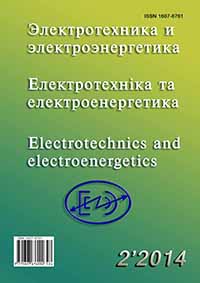ANALYSIS OF FEATURES OF AUTOMATIC CONTROL DUAL MASS ELECTRIC PARAMETERS IN THE SYNTHESIS BASED ON STANDARD CHARACTERISTIC POLYNOMIAL
DOI:
https://doi.org/10.15588/1607-6761-2014-2-7Keywords:
electrical drive, elastic connection, the synthesis of systems, automatic control, the standard method of characteristic polynomials, damping electromechanical couplingAbstract
The article considers the problem of synthesis of automatic control systems for electrical drives with elastic constraints. Analytical dependences, confirming that the optimal transition process to the desired root distribution is realized in electromechanical drive system only at a specific value of the distribution coefficient of inertial mass г, while the speed can not be arbitrarily set.It is shown that under the maximum interaction the elastic two-mass electromechanical system is described by the characteristic polynomial and its coefficients for the implementation of the «inertia» of damping must necessarily take into account the variation of the mechanical subsystem parametersReferences
Ключев В. И. Ограничение динамических нагрузок электропривода / В. И. Ключев. – М. : Энергия, 1971. – 320 с.
Борцов Ю. А. Автоматизированный электропривод с упругими связями / Ю. А. Борцов, Г. Г. Соколовский – 2-е изд., перераб. и доп. – СПб. : Энергоатомиздат, 1992. – 288 с.
Задорожний Н. А. Анализ электромеханического демпфирующего действия в электро-приводах с вязким трением и упругим механическим звеном / Н. А. Задорожний , В. Д. Земляков, А. Г. Ровенский // Электричество. – 1985. – №5. – C. 60–63.
Кузовков Н. Т. Модальное управление и наблюдающие устройства / Кузовков Н. Т. – М. : Машиностроение, 1976. –184 с.
Задорожний Н. А. Оптимизация процессов преобразования энергии электромехани-ческого взаимодействия в электроприводах с упругими связями / Н. А. Задорожний, И. Н. Задорожняя // Тематический выпуск «Проблемы автоматизированного электропривода. Теория и практика» научно-технического журнала «Электро-информ». – Львов : Экоинформ, 2009. – C. 80–81.
Бургин Б. Ш. Анализ и синтез двухмассовых электромеханических систем: монография / Бургин Б. Ш. – Новосибирск : НЭТИ, 1992. –199 с.
Осичев А. В. Стандартные распределения корней в задачах синтеза в электроприводе / Осичев А. В., Котляров В. О., Марков В. С. // Проблемы автоматизированного электропривода. Теория и практика: Труды конференции. – Харьков : Основа, 1997. – С. 104–109.
Задорожний Н. А. Анализ и синтез электромеханических систем управления приводом машин с упругими механическими связями : учебное пособие / Задорожний Н. А., Задорожняя И. Н. – Краматорск : ДГМА, 2010. – 192 с.
Акимов Л. В. Синтез статического регулятора скорости двухмассового электропривода переменного тока ТРН-АД с нелинейной нагрузкой / Л. В. Акимов, Пирожок А. В. // Вісник Національного технічного університету «Харківський політехнічний інститут». – Харків : НТУ «ХПІ», 2002. – Вип.12, Т.1. – C. 124–129.
Задорожняя И. Н. Анализ условий предельной степени демпфирования колебаний в электромеханической системе с упругими связями /И. Н. Задорожняя, Н. А. Задорожний // Вісник Національного технічного університету «Харківський політехнічний інститут». – Харків : НТУ «ХПІ», 2010. – Вип. 28. – C. 210–213.
Downloads
How to Cite
Issue
Section
License
Copyright (c) 2017 I. M. Zadorozhnyaya, N. O. Zadorozhniy

This work is licensed under a Creative Commons Attribution 4.0 International License.
Creative Commons Licensing Notifications in the Copyright Notices
Authors who publish with this journal agree to the following terms:
Authors retain copyright and grant the journal right of first publication with the work simultaneously licensed under aCreative Commons Attribution License that allows others to share the work with an acknowledgement of the work's authorship and initial publication in this journal.
Authors are able to enter into separate, additional contractual arrangements for the non-exclusive distribution of the journal's published version of the work (e.g., post it to an institutional repository or publish it in a book), with an acknowledgement of its initial publication in this journal.
Authors are permitted and encouraged to post their work online (e.g., in institutional repositories or on their website) prior to and during the submission process, as it can lead to productive exchanges, as well as earlier and greater citation of published work.

